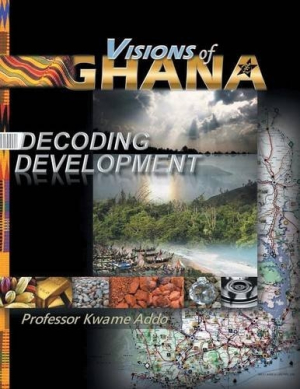Visions of Ghana
Decoding Development
Addo shares a comprehensive vision of Ghanaian advancement and cultural preservation.
From native Ghanaian and development architect Kwame Addo comes an intricate outline for Ghana’s future, focusing on improving infrastructure as well as building upon the soul of a country. Visions of Ghana: Decoding Development is a complex project that packs a lot of vision into a short space.
Addo’s colorfully presented project begins by placing Ghana in historical context, revisiting its geography and history on Africa’s Gold Coast. Early pages contain a brief outline of the nation’s trek toward independence, including sentence-long sketches of political upheavals and coups that ended in the 1992 development of a new national constitution. It is after this point that Addo’s vision truly finds its legs, in an exploration of Ghanaian resources and potential development carefully presented on a time line that demonstrates how the nation could thrive by mid-century.
The book contains a bevy of elaborate charts and graphs that highlight national features in a thorough manner. Such charts display Addo’s exhaustive knowledge of all regions of Ghana, though in their careful detail, they are sometimes hard to navigate.
Maps laying out plans for transportation technology or exploring the country’s agricultural potential hint at Addo’s painstaking, visionary plans but are each printed on a mere page, rendering their legends tiny to the point of illegibility. On such pages, Addo’s vision remains elusive; his presentation would make more of an impact in a more interactive medium.
The prose throughout is clear, and Addo moves quickly through various developmental sections. He discusses Ghana’s future as it relates to the oil industry, tourism, mining and agro-industries, and internal improvement plans, including better waterways and roads. A multitude of topics means that each can only be visited in brief, but Addo’s confident tone and supporting charts suggest that more in-depth plans run beneath this work.
Addo sometimes drifts into romantic territory, particularly when discussing the nation’s landscape: “I suddenly awoke to the enchanting sound of water birds and looked out my window … onto the undulating lands of Nsawam,” he writes near his conclusion. On occasion, he also heads pages with biblical allusions, or places inspiring quotations beneath indexes and graphs. Such choices can be distracting, though a late page devoted entirely to inspirational quotes reinforces the notion that Addo finds such words of wisdom essential to the maintenance of cultural richness. It is merely problematic that this revelation is held off until later in the project.
Overall, Addo’s project should generate much interest among those looking to work toward Ghana’s future, for whom the book could serve as a kind of vision board. Generous servings of detailed graphics suggest ample, careful research, establishing the author as a trustworthy consultant, even when navigating his material becomes an arduous task. Overall, it’s an intelligent and ambitious project.
Reviewed by
Michelle Anne Schingler
Disclosure: This article is not an endorsement, but a review. The publisher of this book provided free copies of the book and paid a small fee to have their book reviewed by a professional reviewer. Foreword Reviews and Clarion Reviews make no guarantee that the publisher will receive a positive review. Foreword Magazine, Inc. is disclosing this in accordance with the Federal Trade Commission’s 16 CFR, Part 255.

